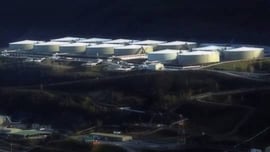Alaska Pipeline Service Company chooses XR Geomembranes secondary containment products to withstand Alaskan weather.
Project Details:
Name: Valdez Marine Terminal
Dates: Installed in 1995
Location: Valdez, AK U.S.A.
Project Story:
The location of Valdez, Alaska is synonymous with one word: oil. Although Valdez is most famous for the Exxon spill in 1989, Valdez and the surrounding area is still responsible for a large amount of crude oil for the United States. One of the major crude oil pipelines ending in Valdez is the Trans Alaskan Pipeline system. This pipeline ends at the Valdez Marine Terminal, located in the northeast corner of Prince William Sound. Owned by the Alyeska Pipeline Service Company, the Valdez Marine Terminal sits on over 1000 acres of land with 14 storage tanks in service, each filled with 510,000 barrels of crude oil. Combined, these tanks house over 7.1 million barrels of crude oil at any given time.
In 1995, the Alaska Pipeline Service Company needed a fabric for the secondary containment of its facility in the unlikely event of a storage tank leak. One critical factor influencing the selection of a liner was the weather. The wide range of temperatures makes Valdez an environmentally sensitive area; the temperature swings from -30° F to +100° F.
Deciding upon the Seaman Corporation's most popular geomembrane liner, XR-5® lines the inside of the dikes around the facility, ensuring both containment and protection. The XR-5 secondary containment fabric has been in service for 18 years with minimal maintenance required.
The XR-5 lining has minimal thermal expansion/contraction, making it durable enough to withstand the widely varying temperatures in Alaska, as well as the other environmental conditions it is exposed to, such as UV rays, ice, wind, and precipitation. Furthermore, the XR-5 geomembrane material with maximum tensile strength has minimal field seams and can be used on slopes. With a track record beginning in 1976 in some of the world's toughest applications, XR-5 is the first choice when maximum tensile strength, high UV resistance and minimal thermal expansion/contraction are required.


